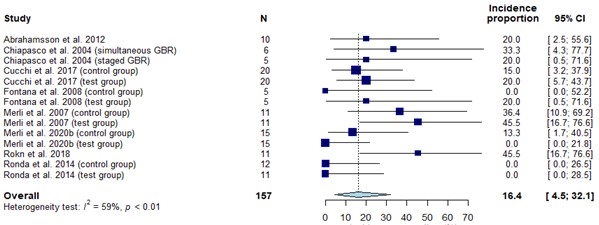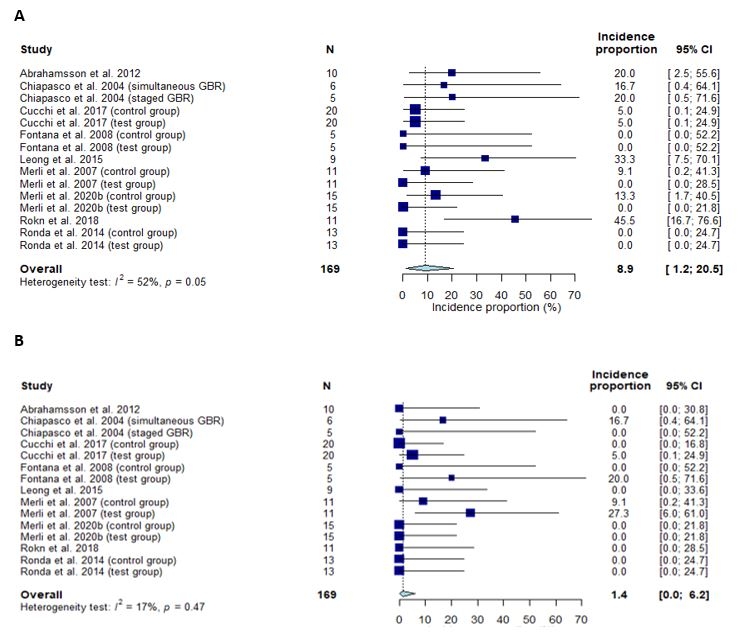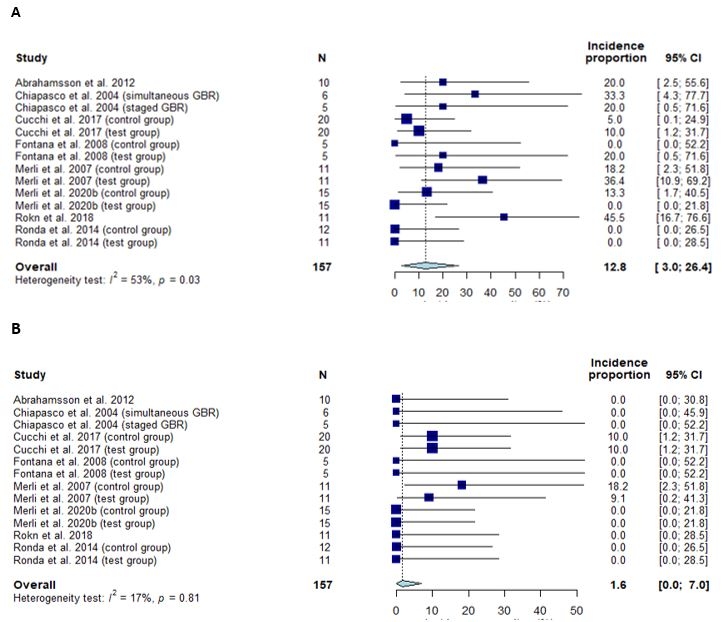IADR Abstract Archives
Post-Surgical Complications and Their Detrimental Effects on Bone Gain in Vertical Guided Bone Regeneration: a Systematic Review and Meta-Analysis
Objectives: Guided bone regeneration (GBR) utilises a barrier membrane to allow osteogenic cells to populate a space by excluding epithelial and connective tissue cells. The purpose of this systematic review was to investigate the incidence of complications after vertical GBR, and the influence of the timing of implant placement and regenerative device on complications. A further aim was to compare the difference in bone gain between sites with and without membrane exposure, and with and without infection occurrence.
Methods: MEDLINE (through PubMed), EMBASE, and Cochrane Central Register of Controlled Trials (CENTRAL) were searched in duplicate up to, and including, November 2020. Only randomised controlled clinical trials were selected. Outcomes included patient-level and site-level incidence of minor and major complications that occurred after vertical GBR. Random-effects and fixed-effects meta-analyses were performed where appropriate. This study was registered on PROSPERO (CRD42021226432).
Results: Nine randomised controlled trials were selected for the primary qualitative and quantitative analyses. The overall patient-level incidence including both major and minor complications was 16.4% [95% CI = 4.5, 32.1]. Patient-level incidence of minor and major complications was 12.8% [95% CI = 3.0, 26.4] and 1.6% [95% CI = 0.0, 7.0]. Site-level incidence of minor complications due to wound dehiscence and infections was 8.9% [95% CI = 1.2, 20.5] and 1.4% [95% CI = 0.0, 6.2]. The type of regenerative device used, staged or simultaneous GBR, had no influence on post-surgical complications. Secondary analyses showed that membrane exposure and infection occurrence results in a significant decrease in bone gain with a ratio of means (RoM) of 0.61 [95% CI = 0.44, 0.84) and 0.56 [95% CI = 0.40, 0.78] respectively.
Conclusions: Post-surgical complications are relatively common surgical complications after vertical GBR. There is a significant reduction in bone gain when post-surgical complications occur.
Methods: MEDLINE (through PubMed), EMBASE, and Cochrane Central Register of Controlled Trials (CENTRAL) were searched in duplicate up to, and including, November 2020. Only randomised controlled clinical trials were selected. Outcomes included patient-level and site-level incidence of minor and major complications that occurred after vertical GBR. Random-effects and fixed-effects meta-analyses were performed where appropriate. This study was registered on PROSPERO (CRD42021226432).
Results: Nine randomised controlled trials were selected for the primary qualitative and quantitative analyses. The overall patient-level incidence including both major and minor complications was 16.4% [95% CI = 4.5, 32.1]. Patient-level incidence of minor and major complications was 12.8% [95% CI = 3.0, 26.4] and 1.6% [95% CI = 0.0, 7.0]. Site-level incidence of minor complications due to wound dehiscence and infections was 8.9% [95% CI = 1.2, 20.5] and 1.4% [95% CI = 0.0, 6.2]. The type of regenerative device used, staged or simultaneous GBR, had no influence on post-surgical complications. Secondary analyses showed that membrane exposure and infection occurrence results in a significant decrease in bone gain with a ratio of means (RoM) of 0.61 [95% CI = 0.44, 0.84) and 0.56 [95% CI = 0.40, 0.78] respectively.
Conclusions: Post-surgical complications are relatively common surgical complications after vertical GBR. There is a significant reduction in bone gain when post-surgical complications occur.
2021 South East Asian Division Meeting (Hong Kong)
Hong Kong
2021
041
Periodontal Research-Therapy
Poster Session
Oral health research III
Wednesday, 12/08/2021 , 12:00PM - 01:00PM
Oral health research III
Wednesday, 12/08/2021 , 12:00PM - 01:00PM
Features of included studies
C, control; CBCT, cone beam computed tomography; CHX, chlorhexidine; cig, cigarettes; CT, computerised tomography; dPTFE, dense polytetrafluoroethylene; ePTFE, expanded polytetrafluoroethylene; FMPS, full mouth plaque score; FMBS, full mouth bleeding score; GBR, guided bone regeneration; mo, months; N.A., not applicable; NR, not reported; no., number; pABG, particulate autogenous bone graft; pDBBM, particulate deproteinised bovine bone mineral; pDFDBA, particulate demineralised freeze-dried bone allograft; pFDBA, particulate mineralised freeze-dried bone allograft; pSDBA, particulate solvent dehydrated bone allograft; PTFE, polytetrafluoroethylene; rCM, resorbable collagen membrane; RCT, randomised controlled trial; SDBA, solvent dehydrated bone allograft; T, test; Ti, titanium; y, years
| Author/ Year/Location | Study design and subject size | Mean age ± S.D. (Range) | Smoking status (%) | Periodontal status (%) | Test (No. of subjects, augmented sites, intervention) | Control (No. of subjects, augmented sites, intervention) | Method of harvesting autogenous bone (if applicable) | Staged/ Simult-aneous GBR | Vertical bone gained after surgery Mean ± S.D. (Range) | Method of assessing vertical bone gained | Size of vertical defect at baseline Mean ± S.D. (Range) | Method of assessing size of vertical defect | Specifications of complications | Appropriateness of site-level and patient-level reporting on complications | Single or multiple augmented/donor site(s) per subject? |
| Abrahamsson et al. 2012 University | RCT (n=20) | T: 27 (range 18-55) C: 25 (range 18-49 years) | 4 smokers (20%) 16 non-smokers (80%) T: 3 smokers C: 1 smoker | NR | 10 subjects (10 sites): Soft tissue expander + pABG + Ti mesh + non-cross-linked rCM | 10 subjects (10 sites): Ramus bone block | T: Bone scraper from a second surgical donor site (ramus) C: Bone block from ramus | Staged | At time of bone grafting T: 4.1±1.7mm (range 3-8mm) C: 2.9±0.9mm (range 2-4mm) At re-entry: T: 3.0±1.4mm (range 0-5mm) C: 1.6±0.8mm (range 0-3mm) | Periodontal probe to measure the distance from titanium mesh to alveolar crest, using mesh as a fixed reference point | NR | N.A. | T: 2 patients (1 site each) had minor perforation during the soft tissue expanding phase No infection or paraesthesia after bone grafting 2 patients (1 site each) with Ti mesh exposure after a few weeks Treated with topical CHX gel 2x/day C: None of the bone blocks were exposed | Yes (one augmented site complication occurred per patient) | Single augmented site; Single donor site |
| Chiapasco et al. 2004 University | RCT (n=21) | 39.8 (range 18-59) | Excluded smokers who smoked >15 cig/day | Excluded patients with active periodontal disease | 11 subjects (11 sites): pABG + Ti-reinforced ePTFE membrane Tenting screws placed for staged cases | 10 subjects (10 sites): Distraction osteogenesis | Bone blocks from ramus (9 patients) or ramus+ chin (2 patients) and particulated with bone mill | Simultaneous (6 subjects); staged (5 subjects) | At time of bone grafting: 4.78±1.25mm | Transparent millimetre ruler to measure distance from top of implant head or tenting screw to most coronal level of direct bone-to-implant contact at mesial and distal of each implant | NR | N.A. | 1 patient (1 site) with membrane exposure at 4w Suppuration even after oral antibiotics, local antiseptics (0.2% CHX 3 times/day + topical CHX gel), therefore membrane removed 1 patient (1 site) with membrane exposure and suppuration at 10w Membrane immediately removed 1 patient (1 site) with membrane exposure at 8w Treated with topical CHX gel for 5mo until membrane removal 2 patents who underwent chin bone block harvest reported paraethesia of lower lip that resolved after 1 and 4 weeks respectively. | Yes (one augmented site complication occurred per patient) | Single augmented site; Multiple donor sites |
| Cucchi et al. 2017 University | RCT (n=40) | 52 | 29 non-smokers (72.5%) 11 smokers (<10 cig/day) (27.5%) | 23 no periodontal disease (57.5%) 12 chronic periodontitis (30%) 5 aggressive periodontitis (12.5%) All periodontitis patients treated with periodontal therapy prior to surgery | 20 subjects (20 sites): pABG + pFDBA + Ti-reinforced dPTFE membrane | 20 subjects (20 sites): pABG + pFDBA + Ti-mesh + cross-linked rCM | Bone scraper within the same surgical site | Simultaneous | At re-entry: T: 4.2±1.0mm C: 4.1±1.0mm | Periodontal probe to measure distance from implant shoulder to first visible bone-implant contact at mesial, distal buccal and lingual sites around each implant | T: 3.8±0.7mm C: 4.0±0.8mm | Periodontal probe to measure distance from implant shoulder to first visible bone-implant contact at mesial, distal buccal and lingual sites around each implant | T: 1 patient (1 site) abscess at 0-1mo: implants, graft, membrane completely removed 1 patient (1 site) with membrane exposure with infection at 1-3mo: implants, graft, membrane completely removed 1 patient (1 site) with membrane exposure without infection at 3-6mo 1 patient reported paraesthesia of the mental nerve with resolution of symptoms during the first mo of surgery C: 1 patient (1 site) abscess at 0-1mo: implants, graft, membrane completely removed 1 patient (1 site) with membrane exposure with infection at 0-1mo: implants, graft, membrane completely removed 1 patient (1 site) with membrane exposure with infection at 1-3mo: only Ti mesh removed 1 patient (1 site) with membrane exposure without infection at 3-6mo 3 patients reported temporary paraesthesia of the mental nerve with resolution of symptoms during the first mo of surgery | No (no information whether paraesthesia occurred in the same patients that experienced membrane exposure) | Single augmented site |
| Fontana et al. 2008 University | RCT (n=5, split-mouth design) | 55 (range 47-66) | Excluded smokers who smoked >10 cig/day | Excluded patients with FMPS and FMBS>25%; no active periodontal disease | 5 subjects (5 sites): pABG + tenting screws + Ti-ePTFE membrane | 5 subjects (5 sites): pDFDBA + tenting screws+ Ti-ePTFE membrane | Trephined from retromolar area and particulated with bone mill (same surgical site) | Staged | At re-entry: T: 5.15±0.34mm (range 4.75-5.50mm) C: 4.90±0.93mm (range 3.25-5.50mm) | Periodontal probe to measure distance from top of tenting screw head to first visible bone-screw contact at mesial and distal sites around each screw | T: 4.70±0.48mm (range 4.00-5.25mm) C: 4.10±0.8mm (range 3.00-5.25mm) | Periodontal probe to measure distance from top of tenting screw head to first visible bone-screw contact at mesial and distal sites around each screw | T: 1 patient reported paraesthesia with resolution of symptoms within 2mo C: 1 patient (1 site) abscess without membrane exposure at 2mo Membrane and infected tissue removed 1 patient reported paraesthesia with resolution of symptoms within 1mo | Yes (one augmented site complication occurred per patient) | Single augmented site |
| Leong et al. 2015 University | RCT (n=16) | 59.4±7.5 (range 44-71) | Excluded all smokers | Excluded patients with poor oral hygiene, periodontal status unknown | ? subjects (9 sites): Block SDBA + tenting screws + non-cross-linked rCM | ? subjects (10 sites): pSDBA + tenting screws + non-cross-linnked rCM | N.A. | Staged | At time of bone grafting: T: 4.0mm C: 4.0mm At re-entry: T: 1.78mm (range 0.0-5.0mm) C: 1.0mm (range -1.0-3.0mm) | Periodontal probe to measure bone height difference after augmentation with a customised stent | Ridge deficiency of 4-6mm | NR | T: 7 sites with wound dehiscence, resulting in one site with total graft failure C: 3 sites with wound dehiscence | No (no mention of how many site-level complications occurred per patient) | NR for augmented sites |
| Merli et al. 2020 Private practice | RCT (n=30) | T: 51.6±14.0 (range 29-77) C: 57.9±13.6 (range 21-74) | 3 smokers (≤20 cig/day) (10%) 17 non-smokers (90%) | NR | 15 subjects (15 sites): pABG + non-cross-linked rCM + osteosynthesis plates (Fence technique) | 15 subjects (15 sites): pABG + pDBBM + non-cross-linked rCM + osteosynthesis plates (Fence technique) | Harvested from intra-oral sites preferably from corpus-ramus of the mandible and particulated with a bone mill | Staged | At re-entry: T: 2.2±1.4mm C: 3.7±1.9mm | Linear vertical distance between the greatest difference, in the superimposed CBCT scans at pre-grafting and re-entry, in the area with gain of bone after grafting | NR | N.A. | T: 2 patients (1 site each) with osteosynthesis plate exposure at 1 and 2mo respectively Treated with topical CHX gel 3x/day for 4mo C: 1 patient reported hypoesthesia with resolution of symptoms at 2mo Treated with α-lipoic acid and Vitamin B complex | Yes (one augmented site complication occurred per patient) | Single augmented site; NR for donor sites |
| Merli et al. 2007 Private practice | RCT (n=22) | T: 44.6 (range 29-59) C: 49.9 (range 36-69) | 4 smokers (18.2%) 18 non-smokers (81.8%) T: 2 smokers C: 2 smokers | NR | 11 subjects (11 sites): pABG + non-cross-linked rCM + osteosynthesis plates (Fence technique) | 11 subjects (11 sites): pABG + Ti-reinforced ePTFE membrane | Captured by filter trap from implant osteotomies and from various intraoral locations | Simultaneous | At re-entry: T: 2.16±1.51mm C: 2.48±1.13mm | Average of maximum and minimum defect height, using the top of the implant-abutment junction as a reference point. Measurements photographed with periodontal probe in situ to identify reference points | T: 2.93±0.86mm C: 2.73±0.79mm | Average of maximum and minimum defect height, using the top of the implant-abutment junction as a reference point. Measurements photographed with periodontal probe in situ to identify reference points | T: 2 patients (1 site each) with abscess Bone graft and barrier membrane completely removed, treated with systemic antibiotics 1 patient (1 site) with membrane exposure without infection Treated with topical application of CHX gel 1 patient (1 site) with abscess at 1w due to not taking the prescribed antibiotics Treated with antibiotics successfully C: 1 patient (1 site) with membrane exposure with infection Bone graft and barrier membrane completely removed, treated with systemic antibiotics 1 patient (1 site) with fistula at 2w, resolved with systemic antibiotics 1 patient (1 site) with fistula at 5mo, resolved with oral hygiene measures 1 patient (1 site) with fistula at 2mo, treated with removal of barrier membrane and systemic antibiotics 1 patient (1 site) with lymph node swelling at 1mo, treated with systemic antibiotics | Yes (one augmented site complication occurred per patient) | Single augmented site; NR for donor sites |
| Rokn et al. 2018 University | RCT (n=11, split-mouth design) | 50.3 | NR | Excluded patients with untreated periodontal disease | 11 subjects (11 sites): Ultrashort (4mm) implants | 11 subjects (11 sites): pABG + pDFDBA + tenting screws + non-cross-linked rCM | Rotary bone harvester from external oblique ridge within the same surgical site | Staged | At re-entry: 2.2±1.1mm | Periodontal probe to measure distance from tenting screw head to cementoenamel junction of adjacent tooth (reference point) | NR Baseline height was 8.1 mm (SD0.9) | N.A. | C: 5 patients (1 site each) with membrane exposure Treated with topical CHX Out of these 5 patients, 3 reported paraesthesia with resolution of symptoms at 2w | Yes (three augmented sites experienced two different complications; two augmented sites experienced one complication) | Single augmented site |
| Ronda et al. 2014 Private practice | RCT (n=23) | 49.6±11.6 (range 30-78) | 8 smokers (<10 cig/day) (34.8%) 15 non-smokers (65.2%) | Excluded patients with untreated or uncontrolled periodontal disease | 12 subjects (13 sites): pABG + pSDBA + Ti-reinforced dPTFE membrane | 11 subjects (13 sites): pABG + pSDBA + Ti-reinforced ePTFE membrane | Bone scraper within the same surgical site | Simultaneous | At re-entry: T: 5.49±1.58mm C: 4.91±1.78mm | Periodontal probe to measure distance from implant shoulder to first visible bone-implant contact on mesial and distal sites around each implant | T: 4.70±1.69mm C: 4.10±1.86mm | Periodontal probe to measure distance from implant shoulder to first visible bone-implant contact on mesial and distal sites around each implant | 3 patients reported paraesthesia with resolution of symptoms 1-4w after surgery No membrane exposures and/or infections | Yes (one augmented site complication occurred per patient) | Multiple augmented sites |



